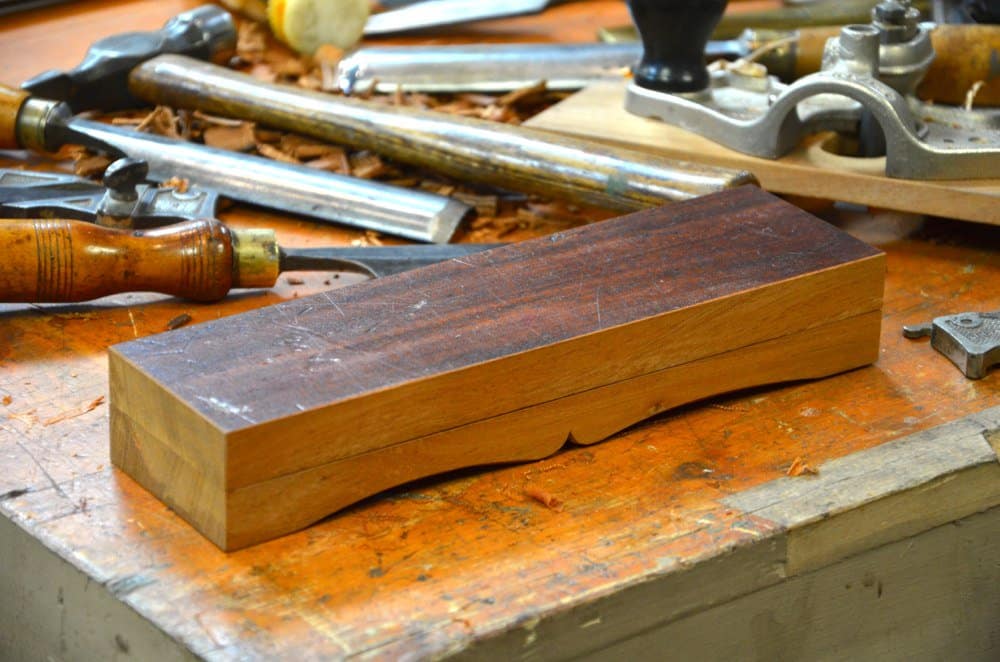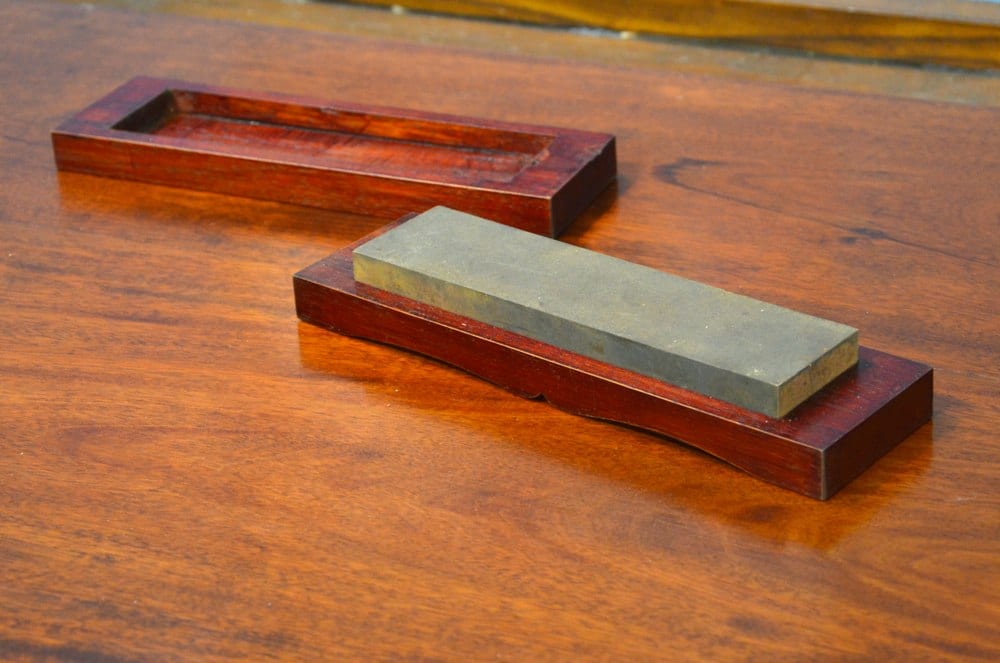Oil Stones and Boxes, Factory-filled and Finishing
For more information on finishes, see our beginner site Common Woodworking.
Question:
I just made a set of these for my oilstones. Unfortunately, I’m going to have to redo them now because I look at yours and then I look at mine and then I look at yours and then I need new boxes that look like you made them and not me!
I’ve heard one should soak their oil stones in their preferred honing oil before using them and then let them sit in a puddle of it in the box when not using them. Most of mine came from garage sales so my honing oil is likely the first oil they’ve seen in 30 years, and I didn’t soak them, I just oiled profusely when I sharpened and if the stone soaked up the oil, I added more. It might be yet another myth to be busted, but how would that work with boxes like these?
Answer:
An unfilled sharpening stone looks like this – dry!
And a filled stone looks like this, oily!
The better quality stones are factory-filled which means they were left in baths or in some cases pressurised containers to force oil into them more quickly and then set aside to allow all excesses to drain off before packaging and shipping out. More inexpensive stones are dry and that means they must be soaked in a light machine oil in a tray or bucket. Whatever you saved in buying a cheaper stone is then lost in buying in the oil. It’s fine to oil non-filled oil stones profusely as you say, but the factory-filled stones need so little oil once filled I think its worth the extra cost.
I have now finished my box and coated it with three coats of coloured shellac to match the original colour of the old table as it was. Shellac isn’t affected by Three-in-1 oil, which is my preferred honing fluid, so adding finish helps to keep things clean with a quick wipe with a rag. Most any finish will work, water-based poly or indeed oil-based poly too. Shellac is fast to dry and less problematic to apply than most other finishes. I used dyes mixed to match the colour I needed.
The lid should be fitted so it’s slightly loose for quick and unhindered removal. I finished the box inside as well as out. People often use the term lubricate the sole but the oil is float off swarf from the stones surface and keeps the cutting surface from clogging which is what happens when you use the stone without oil or honing fluid.
Apply a small puddle of oil to the surface and start honing back and forth.
When you reach the edge and feel the burr you can flip the stone over for a finer surface if its a combination stone with two abrasive grits.
When done, wipe off the oil and the swarf ready for stowing.
Here is the finished box.












I’m still unclear as to why you are now promoting oil stones. On a previous blog you said. ‘I and many others abandoned different natural and man-made stones to adopt diamond plates for three main reasons; they last long, cut fast and stay dead flat.’
I’m neither qualified nor attempting to second guess Paul’s reply, but as per the comment below, many people can’t afford a full set of quality diamond stones. And the truth is oilstones, whilst requiring a bit more care and attention, do a perfectly good job, and have done for decades.
I don’t think he’s really promoting them, I thnk he’s just ended up with one or two inadvertantly and wanted to share the box! A lot of use are using them though, partly because garage sales and estate sales are fruitful places to find them at rock-bottom prices.
David, I’m not promoting them nor not. I sharpened on them for three decades before the diamond plates came along and completed my work just fine. For me the point was exactly as has been shown in answers given; not everyone can afford diamond plates but everyone needs sharp tools. Beyond that, what I am promoting is that there is something lovely about the simplicity of oilstones in craftsman-made oilstone boxes. I’m learning all the more not to throw out the past and so I don’t think we should throw out the whole tradition of lovely and simple oilstone boxes and how to make them seemed important to the conservation of my craft.
Thanks for that clarification, Paul. I accept that to say ‘promoting’ was probably a bit strong. PS. Your pins in the bottom are a typically brilliant, simple idea. I will fit them to the box I made years ago and won’t discard it!
Glad to clear it up. Hope to see you soon. We’re planning an open house in the new year that will be a series of five lectures and then discussions.
I have diamond plates and Japanese-style waterstones but I find myself opting for oilstones more often than not these days – unless I need to remove a lot of metal quickly. They seem more convenient, gentler, less messy (surprisingly) and the oil is more protective of my beloved high-carbon steel woodworking tools.
The waterstones are used for stainless steel kitchen, fishing and dive knives. For fast metal removal, I usually opt for a slow wet grinding wheel and/or diamond plates – it doesn’t take long to establish a cutting edge that way.
Each to his own. I wouldn’t go back, but oilstones of every kind and water stones all work well. Oh, and I haven’t found diamonds aggressive at all as aggression depends on the force of the user, I believe.
I for one am glad Paul has been talking about oilstones. I scraped together enough for an 8×2 600 grit diamond plate but I can’t afford to replace my oilstones (thanks grandad) with a complete set of diamond plates.
I like the box and especially the coloured shellac. I believe it is leather dye, not sure if there are anything special about it or wear to get it but I have been dying to try it (pun intended).
Paul I really like how your box turned out and plan on making for my oil stones as well. I don’t use them often but still have and I do use for certain applications, and been storing them in a plastic box. The wood box looks so much more elegant and gives one some practice as well. Never thought about the Shellac and tinted finish either another good idea.
Steve